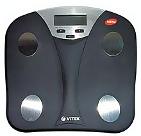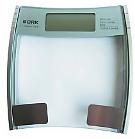The main purpose of the scale is to determine body weight. But the models we tested have an additional feature: by standing on them, you can find out how much fat and how much water is in your body. However, not everyone can use such devices, because during the procedure an electric current passes through the body.
Know yourself
Health is on the scales
When conceiving this test, we wanted to “test for accuracy” the most popular models of electronic household scales. But when we came shopping, we learned that for “the same money” – from 900 to 2300 rubles you can buy not just electronic scales, but body composition analyzer scales. Models of this price group from chain stores of household appliances became participants in the test: Cameron BFS-333, Vitek VT-1953 BK, Bork SC EFG 4315 TR And Tefal BodyUp. Later we learned that Tanita was the first to create such scales, so we purchased a model from the Medtekhnika store Tanita BC-532(3200 rubles). At first they wanted to take it as a standard in determining body composition. And then they decided not to create idols for themselves and test them on a general basis.
Table 1"Technical characteristics and measured parameters of floor scales-analyzers"
| Trademark | TANITA | VITEK | CAMERON | BORK | TEFAL |
|---|---|---|---|---|---|
| Model | BC-532 | VT-1953 VK | BFS-333 | SC EFG 4315 TR | BodyUp |
| Manufacturer country | China | China | China | Germany | France |
| price, rub. | 3200 | 1300 | 900 | 2300 | 2000 |
| Service life, years | 10 | 3 | 3 | 0.5 | 2 |
| Warranty, years | 3 | 1 | 1 | 0.5 | 2 |
| Declared parameters | |||||
| Division price, g | 100 | 100 | 100 | 100 | 100 |
| Maximum user weight, kg | 150 | 150 | 150 | 150 | 160 |
| Memory, man | 4 | 12 | 8 | 10 | 4 |
| “Weight only” function *) | Yes | Yes | Yes | Yes | No |
| Sound alarm | Yes | No | No | No | Yes |
| Batteries | 4AA | 2 CR2032 | 4AA | CR2032 | 2 AAA |
| Dimensions, mm | 365x365x35 | 320x310x34 | 300x305x50 | 305x310x38 | 295x315x55 |
| Functions | Weighing, body fat, visceral fat, water, calories, bone mass, muscle mass, metabolic age, physical type | Weighing, fat, water, muscle mass | Weighing, fat content, water content | Weighing, fat content, water content, calories, muscle mass | Weighing, fat mass |
| Measured parameters | |||||
| Weight of scales, kg | 2,588 | 1,22 | 2,544 | 1,958 | 1,102 | 0,5 | 2 | 10 | 10 | 1 |
| Error when weighing up to 20 kg, kg | 0 | 0 | +0,1 | 0 | +/- 0,1 |
| Error when weighing over 20 kg, kg | 0 | -0,2 | +0,2 | +0,1 | +/- 0,5 |
| Stability of readings | Complies with GOST | Complies with GOST | Complies with GOST | Complies with GOST | Unstable |
Under load
To check the accuracy of the samples, we sent them to the laboratory. There, reference weights were installed on the platform of each model, weighing from the minimum to the maximum value specified in the instructions. Thus, according to manufacturers, all models can withstand up to 150 kg, and scales Tefal– up to 160.
Under the heaviest load, all the scales held up well, only two made the experts worry - plastic Cameron and glass Bork. The first ones creaked desperately, and the second ones had to be placed with the greatest care. But in the end everything worked out - the maximum weight was reached.
Courtesy of Kings
Based on the results of all measurements, the Tanita sample turned out to be the most accurate - it has almost zero error and the highest stability of readings. Laboratory specialists assumed that these scales were calibrated and verified at the factory.
In second place in terms of accuracy were scales Bork– error is only +0.1 kg. This is very good for household scales.
Vitek(-0.2 kg) and Cameron(+0.2 kg) also showed a good result, corresponding to GOST. The readings for both are stable.
And here is a sample Tefal, on the contrary, demonstrated low stability. With the same load, it showed different weights, and deviations reached 0.5 kg, which does not meet the standards. You should not trust such scales, because when the readings fluctuate, it is impossible to determine whether you are gaining or losing weight.
Hold me!
Stepping on the scale is not a tricky thing. But how safe is it? Laboratory staff checked this too.
Let’s say right away: there were no samples that were one hundred percent stable. This is due to the design features of electronic scales. The fact is that the touch sensor (weight detector) is built into their legs, and to prevent the scales from turning over during weighing, you need to stand strictly on the zones intended for this. Safety also depends on the material from which the platform is made and its size.
Model Cameron a bit tall, but quite stable due to the width and weight of the platform. Transverse relief stripes will prevent you from slipping on it.
Feet practically do not slip even on scales Tefal made of matte plastic. However, if you stand on the platform not exactly in the center, the scales may tip over.
The model should be used with great care Bork– its surface is entirely made of smooth glass, which is easy to slip on.
Scales are recognized as the most unstable Tanita. Their developers sacrificed safety for the sake of design delights. The platform of this model is raised almost like a skateboard, and the surface has a surreal shape, with slight differences in height. The areas for the feet are combined from glass and metal, so they cannot be called anatomical.
Rabbits are not only valuable fur...
Knowing your weight is, of course, important. But it is equally important to understand why we gain or lose weight. For example, are we losing weight due to water loss? Does your weight stay stable because fat is transferred to muscle? Or maybe the person just has a “heavy bone”?
Modern scales with a body composition analyzer provide answers to these questions, as they determine the ratio of fat and water in the body. A model Tanita besides, it distinguishes muscle tissue from bone tissue, tells you how much fat you have accumulated on internal organs(visceral fat), and at the same time determines biological age.
Believe it or not?
How to check the accuracy of the body composition analyzer readings? Isn't this quackery?
In search of an answer, we turned to the clinic of the Institute of Nutrition of the Russian Academy of Sciences, to the office of bioimpedansometry (measurement of body composition). The owner of the office, a senior researcher at the clinic, Candidate of Medical Sciences Yunna Pavlovna Popova, explained the principle of operation of such devices, and then made a control measurement on a laboratory device for bioimpedance analysis of body composition. We took the data obtained as a standard and compared the average readings of our models with them.
Almost all test samples, except one, showed very good result– deviation from the standard is no more than 1–2%. And only scales Bork They made a mistake with the definition of fat: they flatter their owners by claiming that their body fat is 6-7% less than it actually is. This is such an optimistic analyzer with built-in “rose-colored glasses”.
It's better not to take risks
Having learned that the bioimpedance analysis procedure involves passing an electric current through the body, we decided to find out whether this is harmful to health. And can everyone use such scales?
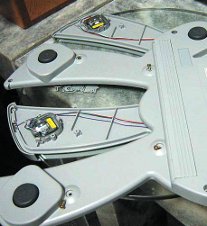
It turned out that there is no clarity on this issue. The instructions for some models state that they are contraindicated for pregnant women and those who use a pacemaker. The instructions for others say that there are no contraindications for pregnant women. With a pacemaker, everything is clear - an electrical discharge can really cause malfunctions in its operation. But the question remains open regarding contraindications for pregnant women.
It is known that expectant mothers often weigh themselves: they need to monitor how their body weight increases as the fetus develops. What will happen if they buy not simple scales, but scales with an analyzer? Moreover, there are more and more such models on sale.
We again turned to Yunna Pavlovna Popova with this question. She replied that there are no special contraindications to the use of bioimpedance measurements for pregnant women. However, guided by common sense, it is better for women expecting to add to their family not to take risks and not use the analyzer. And if such scales have already been purchased, you can simply disable the additional function. By the way, four out of five tested models are Tanita, Vitek, Cameron And Bork provide this opportunity. And only as a sample Tefal“weighing only” mode is not provided.
Not for all
Another important question: Is the body composition analyzer scale easy to use? With models Vitek, Cameron And Bork There are no difficulties thanks to detailed instructions. In addition, the basic functions of these scales (“switch on”, “weighing only”) can be understood intuitively.
At the sample Tanita There are 13 buttons, while the others have no more than 4. However, the thoughtfulness, logic, clarity and excellent description of the functions of each key in the instructions make this model easy to operate.
But in the instructions for the scales Tefal Not only is it not said how to use the “fat analyzer,” but there is not even information on how to turn on the scale. True, on the packaging itself with reverse side Among other advertising inscriptions you can find the phrase: “Automatic switching on when standing on the platform.” And although the automatic operating principle of this device is quite convenient (the user has to perform a minimum of actions), the lack of a description in the instructions can make the purchase useless.
table 2"Test results of floor scales-analyzers"
| Trademark | TANITA | VITEK | CAMERON | BORK | TEFAL |
|---|---|---|---|---|---|
| Model | BC-532 | VT-1953 VK | BFS-333 | SC EFG 4315 TR | BodyUp |
| Weighing accuracy 50% | 5,0 | 4,1 | 4,0 | 4,7 | 1,2 |
| weighing error: 70% | 5,0 | 3,7 | 3,6 | 4,6 | 1,4 |
| up to 20 kg | 5,0 | 5,0 | 4,5 | 5,0 | 4,5 |
| over 20 kg | 5,0 | 3,5 | 3,5 | 4,5 | 1,0 |
| reading stability 30% | 5,0 | 5,0 | 5,0 | 5,0 | 1,0 |
| Body Composition Analyzer Accuracy 20% | 5,0 | 4,5 | 5,0 | 2,0 | 5,0 |
| Ease of use 10% | 3,7 | 3,9 | 3,6 | 4,3 | 2,9 |
| convenience and ease of control 40% | 4,5 | 4,5 | 4,5 | 4,5 | 2,5 |
| platform convenience 20% | 3,5 | 5,0 | 4,0 | 3,5 | 4,5 |
| display size and clarity of readings 20% | 4,5 | 3,5 | 3,0 | 4,5 | 4,0 |
| control keys 20% | 3,0 | 4,0 | 4,0 | 4,5 | 2,0 |
| Design 10% | 4,5 | 4,5 | 2,5 | 4,5 | 4,0 |
| Instructions 10% | 4,5 | 4,0 | 4,5 | 4,5 | 2,0 |
| Final score 100% | 4,3*) | 4,2 | 4,1 | 3,6**) | 2,5 |
Test conclusions:
- Tanita BC 532– original shaped scales with pharmaceutical precision and advanced analyzer functions. This is the most expensive test model (3,200 rubles), but, alas, not the most stable.
- Vitek VT-1953 BK– accurate, stable and convenient scales for a reasonable price (RUB 1,400).
- Sample Cameron BFS-333 demonstrated the best price-quality ratio (900 rubles). The scale and fat analyzer readings are accurate and stable.
- At the scales Bork SC EFG 4315 good weighing accuracy. But this device is let down by the slippery glass surface and significant discrepancies between the fat analyzer readings and the standard.
- Model indications Tefal BodyUp 2024 They are not accurate and stable enough, and the instructions do little to help you master the controls. In addition, it is impossible to simply weigh yourself on a scale by turning off the electric current.
Brief characteristics of the models
- TANITA BC-532
VITEK VT-1953 VK
Advantages: Accuracy and stability of readings within the standard. High accuracy body composition analyzer. The most stable dough model, light and compact. The scales are turned on by tapping on the body. The areas where the feet are located are clearly defined. The supporting surface is made of non-slip plastic, pleasant to the touch.
Flaws: Small display. The scale may turn on spontaneously, for example during transport. This shortens the battery life.
We would like to thank you for your assistance in conducting the tests:
- Nazarov Vladimir Nikolaevich, Candidate of Technical Sciences, Head of the Department of “Metrological Support of Weighing Equipment” of the All-Russian Research Institute of Metrological Service, (FSUE “VNIIMS”);
- Popova Yunna Pavlovna, Candidate of Medical Sciences, senior researcher at the clinic of the Institute of Nutrition of the Russian Academy of Medical Sciences.
First, click on the icon for your gender. Then move the sliders to set your parameters. You will see the results below immediately.
You can discuss the work of the analyzer at.
One of the indicators of health is weight. There is no longer any need to convince anyone of this. You can determine your exact weight at home using floor scales. Mechanical and electronic models were discussed in. In this article we will take a closer look at “smart” scales – analyzers.
Even after knowing your body weight, it is difficult to imagine an accurate picture of the whole body. Two people of the same height and weight can have different level content of water, fat and muscle mass. Of course, you can find out your weight limit yourself. To do this, it is enough to calculate the body mass index (BMI).
BMI=Weight/Height
Height and weight in meters and kilograms, respectively.
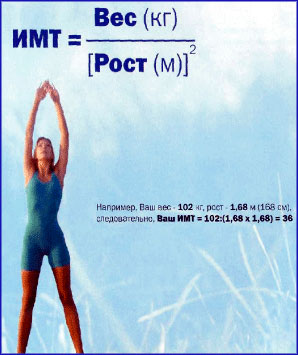
From a medical point of view, an interpretation of these indicators has been developed, which will allow you to understand what your weight should be.
16 – body weight deficiency (severe);
16-17.9 – underweight;
18-24,9 – normal weight bodies;
25-29.9 – overweight;
30-34.9 – 1 degree of obesity;
35-39.9 – 2nd degree of obesity;
40 – 3rd degree of obesity.
Normal weight For women, according to the BMI formula, it ranges from 19-24. Pregnant women should not rely on this indicator. A man's normal weight is considered to be a BMI of 25 to 27.
Calculating BMI allows you to indirectly assess the norm of weight: is your body weight normal, insufficient, or present? excess weight. However, these calculations cannot be called universal. Children and people with large muscle mass should not be guided by these indicators. In this case, it is necessary to study body composition. Bathroom scales with a fat and body composition analyzer will help with this.

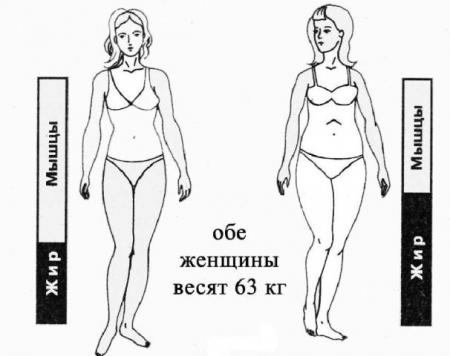
Floor scales fat analyzers: design and principle of operation
Fat analyzers are electronic floor scales, which are a platform with electrodes. Standing on the platform, the monitor sends imperceptible electrical impulses that pass through the body.
Lean tissue contains extracellular, intracellular fluid and electrolytes that offer low resistance to electrical current impulses. Fatty tissues contain less water, so they have high resistance. These resistances are compared to the person's weight. Based on this, the water and fat levels are calculated. The first devices to use this technology were Tanita analyzer balances (in 1946).
Body Analyzer
Body analyzer scales measure not only the percentage of fat and water in the body, but also the mass of skeletal muscles. Some models calculate a person's biological age. These devices are equipped with memory, and the error ranges from 0.1 to 0.01 kg.
The simplest body weight analyzers have 4 electrodes. Modern professional models are equipped with 8 electrodes. During the measurement, a person stands on the platform and additionally holds onto the handles with electrodes. This procedure allows for segmental analysis of the trunk, legs and arms.



Which body analyzer scales to buy is a personal choice for everyone. A table with technical characteristics popular models:
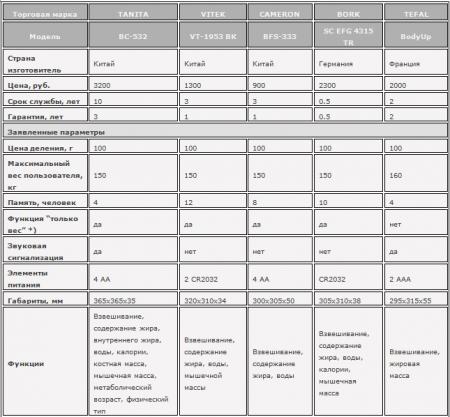
Analyzer scales: contraindications
The body analysis procedure involves the need for electrical current to pass through the body. No one can give a clear answer whether it is harmful or not. The instructions for some devices do not contain contraindications, while others do not recommend use by people with pacemakers and pregnant women. Let's use common sense and not take risks. Although some models, such as Bork, Cameron, Tanita and Vitek, provide the ability to measure only body weight. Only Tefal scales do not have this function.
Analyze your body and be healthy!
Among the many electronic measuring instruments, diagnostic models occupy a special position. For example, electronic floor scales with a body composition analyzer can determine not only the total weight, but also by “looking” inside human body, establish the mass of fat, bone and muscle tissue, as well as the volume of water. Let's look at the principle of their operation in more detail.
Conventional measuring devices show our total weight, taking into account only fat mass, not taking into account muscle, water and bone mass. Such information is relevant for us if we weigh ourselves in order to obtain data about our weight. For example, when we are interested in knowing what body weight was before and after childbirth.
Diagnostic scales with a fat analyzer determine not only total weight, but can also determine the risk of disease and determine the effectiveness of physical activity and find out your metabolic age. Their cost is far from low, but the device is worth it.
Functionality
Measuring instruments equipped with a body composition analyzer are unsurpassed. With their help, medical workers, nutritionists, people involved in sports, fitness trainers, and simply those who lead correct image life, can find out such indicators as:
- Total weight.
- Body fat content (for children over 5 years old, for adults over 17 years old, different manufacturers may use different age categories).
- Weight bone mass.
- The volume of water in the body.
- Muscles.
- Metabolic age.
- Amount of visceral fat: This accumulates around the abdominal organs.
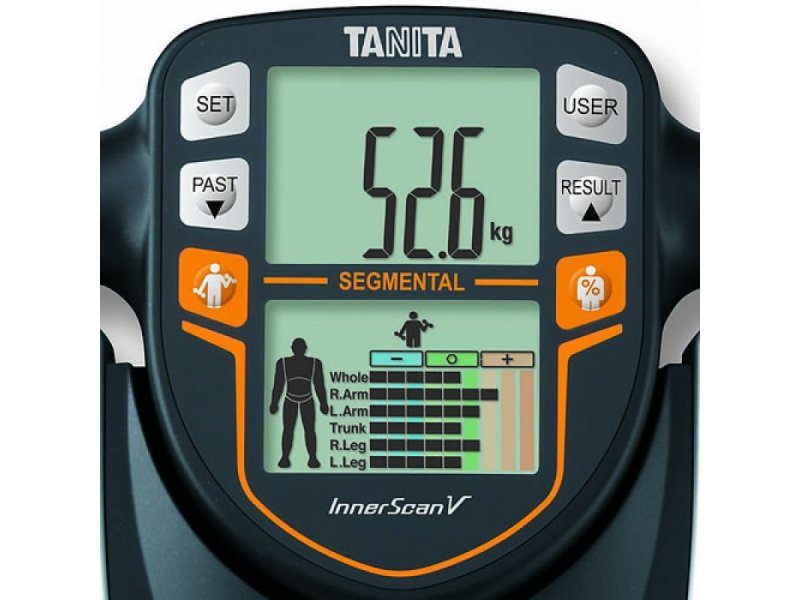
Principle of operation
The operation of the device is carried out by the influence electrical impulses. The main advantage of the device is the built-in body composition analyzer. The fact is that biological tissues in the human body have a certain electrical conductivity value.
The principle of operation of the scale is based on the bioelectric resistance provided by our body. Thanks to this physiological feature of the body, it becomes possible to determine its composition and volume.
When an electric current passes through the body, the organic mass easily transmits impulses due to the presence of liquids. In muscles its concentration is within 75%. But in adipose tissue the volume of fluid is minimal, which means that the resistance in it will be higher. The technique is called BIA (bioelectronics impedance analysis). Reducing the standard voltage between the electrodes through which this pulse is passed allows the resistance to be calculated. And the BIA body analyzer program, which is equipped with all diagnostic scales, analyzes the result and displays an individual result.
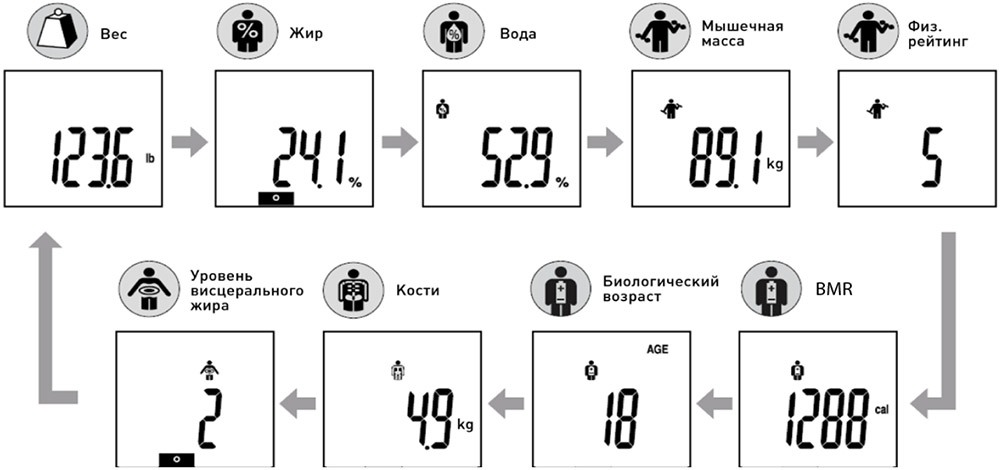
Mechanism for reading received information
The latest generation electronic scales with a body composition analyzer are equipped with metal electrodes that are built into their platform. When a person stands on a diagnostic scale, a low-frequency pulse is passed through his body. It is not possible to sense this signal; for us it is absolutely safe.
Our body consists of various tissues, fat, bone, including water. The passing impulse will encounter resistance along its path, thanks to which it will be possible to establish the exact ratio of water and fat.
Having received the result, the BIA program will compare the data with the age, gender and height of the person being studied, and give a personal result. In addition to these indicators, floor scales with an analyzer will indicate other data: metabolic age, as well as the amount of fat accumulated around the abdominal organs.
Why are they needed?
Analyzer scales are indispensable for people following a therapeutic or sports diet.
Using this innovative measuring device, you can monitor not only your weight, but also the condition of the body as a whole.
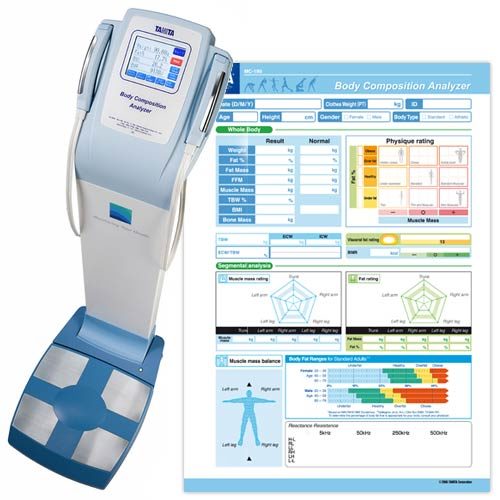
The data that these scales provide about body composition will be useful when compiling healthy diet, to prevent many serious diseases (diabetes, cardiovascular and cancer diseases). For example, obesity is the source of many diseases, and low water content in the body disrupts metabolism and contributes to early aging.
How to choose
Anyone with varying financial income can afford to buy diagnostic scales. The cost of such a device starts from 1500 rubles. Although the price of some products can reach up to 100 thousand. The variation in cost indicates the presence of distinctive characteristics:
- segment-by-segment analysis (each arm, leg and torso);
- maximum load capacity up to 270 kg;
- wireless communication for connecting to a computer or other device for transmitting data obtained as a result of weighing;
- availability of memory in some models – up to 4 users;
- automatic identification of a person stepping on the scale;
- metabolic age reading;
- measurement of visceral fat mass.
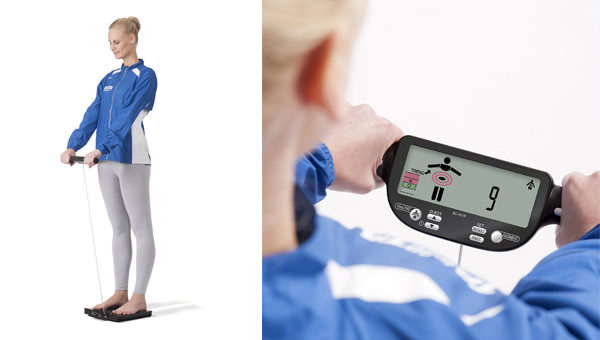
Conclusion
Diagnostic scales with a fat analyzer can be considered a new generation device. With their help, you can find out not only the total weight of your body, but also its composition. Athletes, people who are obese or have some kind of disease, or simply those who monitor their health will appreciate such a measuring device.
Indeed, sometimes it is not enough just to know your weight; you often need to have more detailed information, have data on the mass of bone and fat tissue, and the amount of water in the body. Floor scales-analyzers provided us with such an opportunity. Having such a device at home, a person can easily carry out diagnostics on their own.
